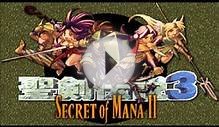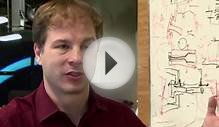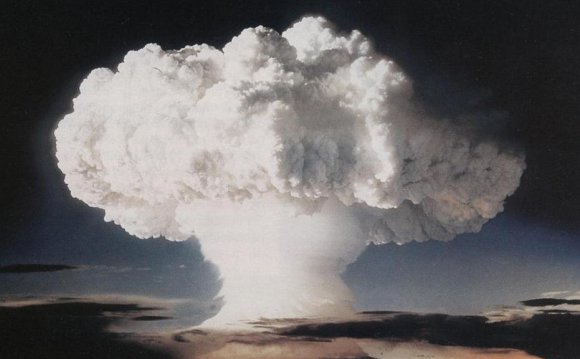
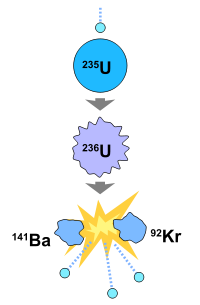 A nuclear weapon is commonly defined as a device, which uses a nuclear reaction for destructive means.
A nuclear weapon is commonly defined as a device, which uses a nuclear reaction for destructive means.
Introduction
The first nuclear weapon was successfully detonated on July 16, 1945. The nuclear weapon, code named “Trinity”, yielded an explosion which was equivalent to 20 kilotons of Trinitrotoluene (TNT). This reaction unexpectedly had a shock wave which could be felt 100 miles away. Compared to chemical reactions, the amount of energy that can be released from nuclear reactions can be up to a million times greater. Before we can fully understand the chemical complexity and appreciate the engineering elegance of a nuclear weapon, however, it is important to grasp basic nuclear chemistry concepts.
Basic Nuclear Chemistry Definitions and Concepts
Nuclear Fission- This type of nuclear reaction is caused by nuclear decay of an unstable atom that has been hit by a neutron. As a result of the instability of the atom, the nucleus splits into two fission fragments also yielding free neutrons and exorbitant amounts of energy (both in the form of electromagnetic radiation and kinetic energy). A neutron carries no electric charge but the nucleus of an atom does - a positive charge.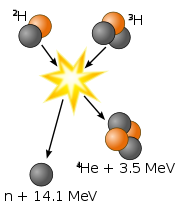 Like with magnets, like charges repel each other, so particles that carry positive electric charges like alpha particles are repelled by the nucleus of an atom and thus do not stick to the nucleus. However, a neutrally charged neutron can combine with the nucleus of an atom which then causes the nucleus to become unstable and split into 2 nuclei. According to Einstein's formula, \(E=mc^2\), energy is released from this reaction along with other neutrons that have the same effect on nearby nuclei and a chain reaction occurs which yields an incredible amount of energy.
Like with magnets, like charges repel each other, so particles that carry positive electric charges like alpha particles are repelled by the nucleus of an atom and thus do not stick to the nucleus. However, a neutrally charged neutron can combine with the nucleus of an atom which then causes the nucleus to become unstable and split into 2 nuclei. According to Einstein's formula, \(E=mc^2\), energy is released from this reaction along with other neutrons that have the same effect on nearby nuclei and a chain reaction occurs which yields an incredible amount of energy.
Figure 1: Picture of the Fission reaction of Uranium-236 producing fission fragments, neutrons and 3.20X1011 Joules of energy. Provided by "Wikipedia".
Nuclear Fusion- Fusion is almost completely complimentary to fission. It is the process in which a nuclear reaction where two nuclei are joined together to form a heavier nucleus. The reaction also yields free neutrons and exorbitant amounts of energy from binding energy. Our sun is a "nuclear furnace" in the sense that it is a place where nuclear fusion occurs.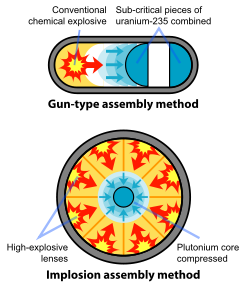 Although a nuclear fusion reactor would undoubtedly be better for our environment, such reactions are not yet possible because no known material can withstand the incredible high temperatures needed for such reactions to occur.
Although a nuclear fusion reactor would undoubtedly be better for our environment, such reactions are not yet possible because no known material can withstand the incredible high temperatures needed for such reactions to occur.
Figure 2: An example of nuclear fusion in which deuterium and tritium fuse together to form helium-4 and freeing a neutron. Provided by "Wikipedia".
Example of Fusion Reaction
2D+3T → 42He +10N + 17.6 MeV
Fissile / Fissionable – An atom is fissionable if it is capable of undergoing fission. If an atom is Fissile it is not only able to undergo fission, but it is also capable of sustaining a nuclear chain reaction.
Nuclear Chain Reaction- As stated earlier in the text, a nuclear fission reaction yields free neutrons. In a nuclear chain reaction, the free neutrons from a nuclear fission reaction bombard nearby Fissile isotopes resulting in multiple fission reactions. These reactions result in colossal amounts of kinetic energy and gamma radiation.
Critical Mass- The amount of fissile isotope required to successfully assist a nuclear chain reaction. If the fissile material is at a subcritical mass it cannot sustain a nuclear chain reaction. On the other hand, if the fissile material is at a supercritical mass, it will undergo a chain reaction at a faster rate.
Nuclear Weaponry
A nuclear weapon can either undergo a nuclear fission reaction (atomic bomb) or a nuclear fusion reaction (H bomb or thermonuclear bomb).
YOU MIGHT ALSO LIKE

